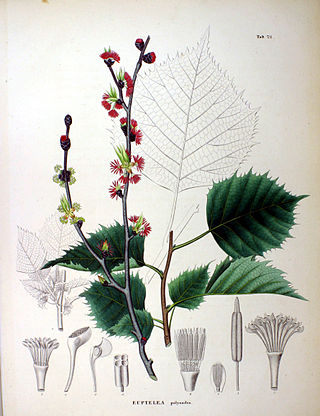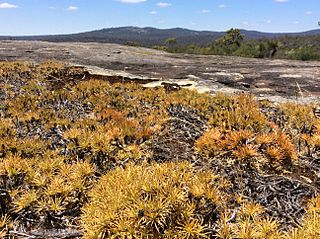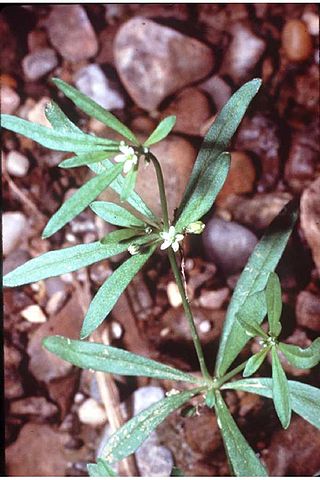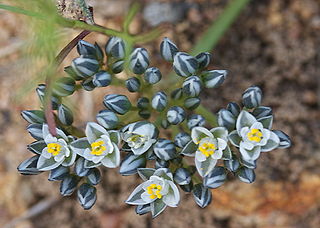
The Malpighiales comprise one of the largest orders of flowering plants, containing about 36 families and more than 16,000 species, about 7.8% of the eudicots. The order is very diverse, containing plants as different as the willow, violet, poinsettia, manchineel, rafflesia and coca plant, and are hard to recognize except with molecular phylogenetic evidence. It is not part of any of the classification systems based only on plant morphology. Molecular clock calculations estimate the origin of stem group Malpighiales at around 100 million years ago (Mya) and the origin of crown group Malpighiales at about 90 Mya.

The Polygonaceae are a family of flowering plants known informally as the knotweed family or smartweed—buckwheat family in the United States. The name is based on the genus Polygonum, and was first used by Antoine Laurent de Jussieu in 1789 in his book, Genera Plantarum. The name may refer to the many swollen nodes the stems of some species have, being derived from Greek [poly meaning 'many' and gony meaning 'knee' or 'joint']. Alternatively, it may have a different origin, meaning 'many seeds'.

Austrobaileyales is an order of flowering plants consisting of about 100 species of woody plants growing as trees, shrubs and lianas. The best-known species is Illicium verum, commonly known as star anise. The order belongs to the group of basal angiosperms, the ANA grade, which diverged earlier from the remaining flowering plants. Austrobaileyales is sister to all remaining extant angiosperms outside the ANA grade.

The Angiosperm Phylogeny Group (APG) is an informal international group of systematic botanists who collaborate to establish a consensus on the taxonomy of flowering plants (angiosperms) that reflects new knowledge about plant relationships discovered through phylogenetic studies.

Dilleniaceae is a family of flowering plants with 11 genera and about 430 known species. Such a family has been universally recognized by taxonomists. It is known to gardeners for the genus Hibbertia, which contains many commercially valuable garden species.

The eudicots, Eudicotidae, or eudicotyledons are a clade of flowering plants mainly characterized by having two seed leaves upon germination. The term derives from Dicotyledons.

The rosids are members of a large clade of flowering plants, containing about 70,000 species, more than a quarter of all angiosperms.

Siparunaceae is a family of flowering plants in the magnoliid order Laurales. It consists of two genera of woody plants, with essential oils: Glossocalyx in West Africa and Siparuna in the neotropics. Glossocalyx is monospecific and Siparuna has about 74 known species.

Euptelea is a genus of two species of flowering plants in the monogeneric family Eupteleaceae. The genus is found from Assam east through China to Japan, and consists of shrubs or small trees:

Boryaceae is a family of highly drought-tolerant flowering plants native to Australia, placed in the order Asparagales of the monocots. The family includes two genera, with twelve species in total in Australia.

Ixiolirion is a genus of flowering plants native to central and southwest Asia, first described as a genus in 1821. Recent classifications place the group in the monogeneric family Ixioliriaceae in the order Asparagales of the monocots. In earlier systems of classification, it was usually placed in the family Amaryllidaceae.

The Molluginaceae are a family of flowering plants recognized by several taxonomists. It was previously included in the larger family Aizoaceae. The APG III system of 2009 made no change in the status of the family as compared to the APG II system of 2003 and the APG system of 1998, apart from a reassignment of several genera, such as the placement of Corrigiola and Telephium into Caryophyllaceae, Corbichonia in Lophiocarpaceae, Microtea into Microteaceae and Limeum in Limeaceae, because the family was found to be widely polyphyletic in Caryophyllales. In addition Macarthuria was found not to be related to Limeum as previously thought and thus it was placed in Macarthuriaceae, and similarly species formerly placed in Hypertelis, apart from type species Hypertelis spergulacea, a true Molluginaceae, were found to belong elsewhere and were described as Kewa in the family Kewaceae, named for the Royal Botanic Gardens Kew. Molluginaceae is still assigned to the order Caryophyllales in the clade core eudicots, although the generic circumscription is difficult because Mollugo is not monophyletic.

Caryophyllales is a diverse and heterogeneous order of flowering plants that includes the cacti, carnations, amaranths, ice plants, beets, and many carnivorous plants. Many members are succulent, having fleshy stems or leaves. The betalain pigments are unique in plants of this order and occur in all its families with the exception of Caryophyllaceae and Molluginaceae.

Dr Maarten Joost Maria Christenhusz is a Dutch botanist, natural historian and photographer.

Limeum is a genus of flowering plants. It includes 25 species.

Kewa is a genus of flowering plants, consisting of eight species of succulent sub-woody plants, native to eastern and southern Africa, including Saint Helena and Madagascar. These are small shrubs or herbs that form cushions and have edible, acid-tasting leaves. Kewa is the only genus in the family Kewaceae.

The superrosids are members of a large clade of flowering plants, containing more than 88,000 species, and thus more than a quarter of all angiosperms.

Kewa acida is one of the eight species currently recognized in the genus Kewa, the sole genus in the family Kewaceae. It is a bushy grey-leaved annual or short-lived perennial plant, with white flowers, endemic to St Helena, where it has been called the "salad plant". It is regarded as Critically Endangered. The succulent leaves are high in Vitamin C and were used by sailors in the past as a scurvy preventative.

The superasterids are members of a large clade of flowering plants, containing more than 122,000 species.



















